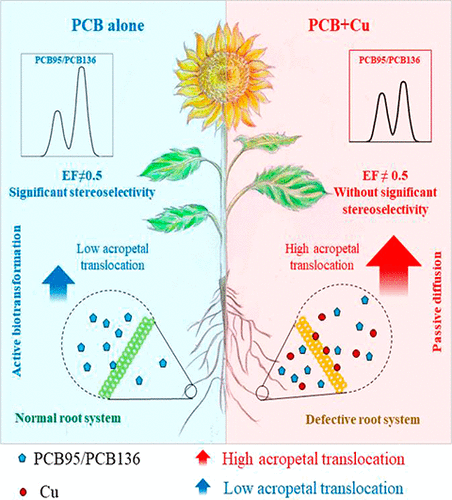当前位置:
X-MOL 学术
›
Environ. Sci. Technol.
›
论文详情
Our official English website, www.x-mol.net, welcomes your
feedback! (Note: you will need to create a separate account there.)
Reflection of Stereoselectivity during the Uptake and Acropetal Translocation of Chiral PCBs in Plants in the Presence of Copper
Environmental Science & Technology ( IF 10.8 ) Pub Date : 2017-11-16 00:00:00 , DOI: 10.1021/acs.est.7b03350 Shaorui Wang 1 , Chunling Luo 1, 2 , Dayi Zhang 3 , Yan Wang 4 , Mengke Song 2 , Zhiqiang Yu 1 , Yujie Wang 5 , Gan Zhang 1
Environmental Science & Technology ( IF 10.8 ) Pub Date : 2017-11-16 00:00:00 , DOI: 10.1021/acs.est.7b03350 Shaorui Wang 1 , Chunling Luo 1, 2 , Dayi Zhang 3 , Yan Wang 4 , Mengke Song 2 , Zhiqiang Yu 1 , Yujie Wang 5 , Gan Zhang 1
Affiliation

|
Plant uptake and acropetal translocation of polychlorinated biphenyls (PCBs) is a major concern, with many uncertainties, especially when plants are exposed to coexisting PCBs and metals. Studying atropisomer selectivity behavior is a well-proven method for identifying the biotransformation process of chiral PCBs in plants. This study investigated the uptake, translocation, and stereoselectivity of PCB95 and PCB136 (3 μg/L in hydroponics and 200 μg/kg in pot experiment) by monocot corn and dicot sunflower after copper (Cu) exposure (50 μmol/L in hydroponics and 400 mg/kg in pot experiment). Cu exposure led to significantly increased PCBs accumulation in roots and enhanced their acropetal translocation from roots to shoots, attributed to Cu-induced root damage. In the absence of Cu, the first-eluting enantiomer of PCB95 and second-eluting enantiomer of PCB136 were preferentially enriched in the shoots and roots of both the monocot and the dicot, and the enantioselectivity of chiral PCBs was more pronounced in shoots than in roots. Cu exposure significantly reduced the stereoselectivity of PCB95 and PCB136 in the defective root system, implying that PCB95 and PCB136 uptake into roots after Cu exposure changed from active biotransformation to passive diffusion. Our findings suggest that the ecological risk of PCB95 and PCB136 uptake and accumulation in plants is underestimated at sites cocontaminated with metals and PCBs and, for the first time, reveal the mechanism associated with the uptake and biotransformation of chiral PCBs in plants after exposure to both heavy metals and chiral PCBs.
中文翻译:

铜存在下植物对手性多氯联苯的吸收和顶体易位期间的立体选择性反应
多氯联苯(PCB)的植物吸收和顶体易位是一个主要问题,存在许多不确定性,尤其是当植物暴露于多氯联苯和金属共存的情况下。研究阻转异构体的选择性行为是一种成熟的方法,用于鉴定植物中手性多氯联苯的生物转化过程。这项研究调查了单子叶玉米和双子叶植物向日葵在铜(Cu)暴露后(水培和水培分别为50μmol/ L)对PCB95和PCB136(水培法为3μg/ L,盆栽实验为200μg/ kg)的吸收,转运和立体选择性。盆栽实验中为400 mg / kg)。铜暴露导致根中PCBs的积累显着增加,并导致其从根到芽的顶囊易位,这归因于Cu诱导的根部损害。在没有铜的情况下 在单子叶植物和双子叶植物的枝条和根中,PCB95的第一个洗脱对映体和PCB136的第二个洗脱对映体都富集,手性PCB的对映选择性比根中更明显。暴露于铜会显着降低缺陷根系中PCB95和PCB136的立体选择性,这意味着暴露于Cu后,PCB95和PCB136会从主动生物转化变为被动扩散而吸收到根中。我们的研究结果表明,植物中PCB95和PCB136吸收和积累的生态风险在被金属和PCB共同污染的地点被低估了,这首次揭示了暴露于两种植物中手性PCB吸收和生物转化的机制。重金属和手性多氯联苯。
更新日期:2017-11-17
中文翻译:

铜存在下植物对手性多氯联苯的吸收和顶体易位期间的立体选择性反应
多氯联苯(PCB)的植物吸收和顶体易位是一个主要问题,存在许多不确定性,尤其是当植物暴露于多氯联苯和金属共存的情况下。研究阻转异构体的选择性行为是一种成熟的方法,用于鉴定植物中手性多氯联苯的生物转化过程。这项研究调查了单子叶玉米和双子叶植物向日葵在铜(Cu)暴露后(水培和水培分别为50μmol/ L)对PCB95和PCB136(水培法为3μg/ L,盆栽实验为200μg/ kg)的吸收,转运和立体选择性。盆栽实验中为400 mg / kg)。铜暴露导致根中PCBs的积累显着增加,并导致其从根到芽的顶囊易位,这归因于Cu诱导的根部损害。在没有铜的情况下 在单子叶植物和双子叶植物的枝条和根中,PCB95的第一个洗脱对映体和PCB136的第二个洗脱对映体都富集,手性PCB的对映选择性比根中更明显。暴露于铜会显着降低缺陷根系中PCB95和PCB136的立体选择性,这意味着暴露于Cu后,PCB95和PCB136会从主动生物转化变为被动扩散而吸收到根中。我们的研究结果表明,植物中PCB95和PCB136吸收和积累的生态风险在被金属和PCB共同污染的地点被低估了,这首次揭示了暴露于两种植物中手性PCB吸收和生物转化的机制。重金属和手性多氯联苯。











































 京公网安备 11010802027423号
京公网安备 11010802027423号